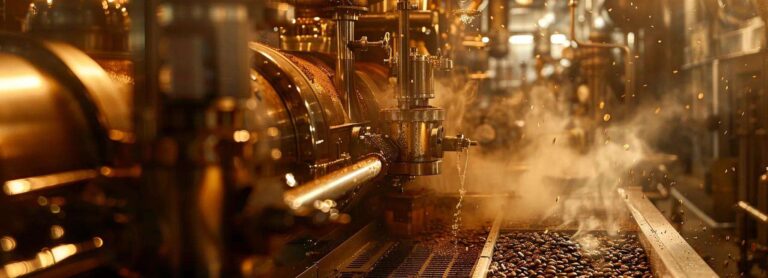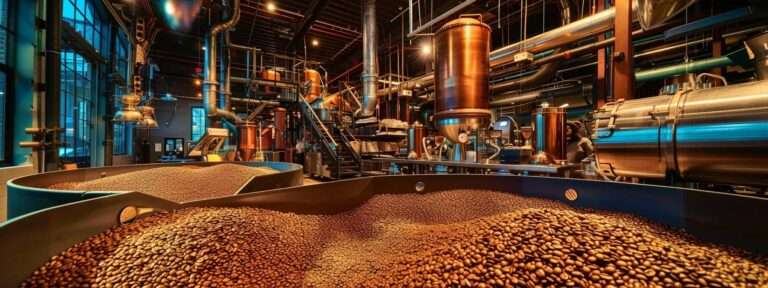Coffee, a brew steeped in history, embarked on its flavorful journey with rudimentary roasting in the humble abodes of ancient civilizations.
As it spread through Europe, the dark beans toasted in the bustling markets of the Ottoman Empire, hinting at the dawn of coffee culture as an art form.
Now, home roasting coffee enthusiasts and specialty coffee aficionados alike refine their crafts, marrying tradition with the precision of modern science.
They turn each batch into a canvas, painting with heat and timing to create the perfect cup.
Stay tuned as we trace the remarkable evolution of coffee roasting from its roots to the flourishing artisanal movements of today.
The Ancient Roots of Coffee Roasting Practices
Tracing the transformative journey of coffee from its humble beginnings to a ritualized beverage requires a visit to ancient Ethiopia, where the captivating aroma first permeated the air as locals honed the earliest methods of coffee preparation.
Ethiopian practices paved the way for coffee’s eventual embrace in cultural hubs from the United Kingdom, where the coffeemaker became an emblem of domestic sophistication, to France, where it intertwined with the social fabric of café culture.
Yet, it was the distinctive allure of Turkish coffee, a testament to the meticulous art of roasting and brewing, that marked one of the most pivotal chapters in coffee’s global voyage.
As traders spirited these cherished beans across continents, they inadvertently wove a narrative of connection and transformation that reverberates in every steaming cup enjoyed around the world today.
Discovering Coffee in Ethiopia and Its Early Uses
Amidst the rugged landscapes of Ethiopia, an accidental discovery occurred when shepherds noticed their goats brimming with energy after munching on a peculiar plant. Curious tasting ensued, and soon after, the seeds of the bright red cherries from the coffee plant found their way into the flames, a primitive forerunner to the roasting we know today.
In the warmth of an Ethiopian kitchen, these early adopters of coffee prepared the beans akin to how we might cook popcorn, listening for the crackling sounds that signaled a transformation. Little did they know that their simple, flavorful concoctions would lay the groundwork for what would become, by the time of the industrial revolution, a pursuit for refined excellence and a treasured element of trade with Yemen and beyond.
Trading Across Continents: How Coffee Spread Worldwide
The odyssey of coffee’s proliferation is a story etched with innovation and cultural adaptation; as roasting techniques refined, the beverage transcended its Ethiopian origin. Germany’s own contribution, through the ingenuity of their coffee roasting mechanisms, played a pivotal role in broadening coffee’s appeal and facilitating its absorption into daily life across Europe.
On the shores of the Pacific Northwest, Seattle emerged as a contemporary mecca for coffee enthusiasts, where the quest for the perfect latte became synonymous with the city’s bustling energy. Here, old-world traditions met new-school styles, propelling the coffee culture into a phenomenon that reshaped social interactions and morning rituals worldwide.
Turning Points in Coffee Roasting Technology
The evolution of coffee roasting from the ancient coffee ceremony of Ethiopia and Eritrea to its modern variations is a tale marked by significant technological advancements.
As the allure of the coffee bean captivated the palates of Europe, the first roasting machines surfaced, providing a departure from the days of artisanal roasting over open flames.
The inception of these machines in Europe was a monumental step, revolutionizing the aromas and flavors that previously filled the air with heavy smoke.
With the progression from the 19th to the 21st century, innovations have continued to emerge, driven by an unquenchable thirst for perfection and efficiency, further shaped by the global connectivity fostered by the internet.
This continuous reinvention of coffee roasting is a testament to its enduring legacy and the persistent quest for the perfect brew.
The Introduction of the First Roasting Machines in Europe
Europe’s foray into mechanized roasting began as an experiment, a departure from the frying pan and stove that had long been the tools of coffee artisans. Pioneers in this domain sought methods to more precisely manage the heat and moisture crucial to unlocking the flavors enshrined within beans sourced from Africa’s rich soils.
The introduction of these groundbreaking machines offered roasters control unattainable by the rudimentary means of the past, enabling them to consistently reach the ideal roast without the unpredictability that once came hand-in-hand with the art form.
Innovations From the 19th to the 21st Century
As understanding of the roasting process deepened, the 19th century heralded a significant shift. The invention of the drum roaster brought a uniform heat that was previously elusive, transforming the raw, green bean into a flavorful delicacy with an accuracy that redefined industry standards.
With the 20th and early 21st centuries, coffee’s popularity soared, and the coffeehouse became a symbol of urban sophistication. Advancements such as precise humidity controls and programmable roast profiles enabled artisans and baristas alike to tailor the roasting process to the individual characteristics of each bean, ensuring coffee aficionados could consistently indulge in a superior cup.
Cultural Influences on Coffee Roasting Styles
Delving into the annals of history, legends as rich as the brew itself tell of roasting traditions that span the globe.
In Colombia, a land synonymous with the coffee bean, the precise application of heat begets a range of roasts that tell a story of locality and taste.
Traveling to the Arabian Peninsula and Turkey reveals a cultural devotion to light roasting, where technique and tradition fuse to bring forth delicate flavors appreciated for centuries.
Yet, as we traverse westward, preferences evolve—rich, dark roasts emerge, offering a stark contrast to the lighter fare.
These preferences are not merely gustatory; they are historical waypoints reflecting the cultural dynamics influencing coffee roasting styles from the Middle East to the bustling cafés of Western metropolises.
Middle Eastern Traditions and the Art of Light Roasting
In the warm embrace of Middle Eastern tradition, the art of roasting coffee is akin to a sacred dance with heat and time, where the bean is carefully coaxed to release its delicate acidity and complex flavors without the darkened hues born of longer roasts. Here, the natural gas-fueled flames lick the surface of the beans in a process steeped in centuries of refinement, an approach that complements the regional predilection for lightly roasted delicacies.
Within the bustling souks and serene private homes alike, the espresso machine remains a foreign concept, as locals favor the gentle brew drawn from meticulously light-roasted coffee. This precise method, which ends shortly after the first crack, highlights the intrinsic qualities of the beans and stands as a testament to a region’s profound influence on the entire spectrum of coffee production and enjoyment.
Western Evolution Towards Darker Roast Preferences
Western preference for darker roasts can be traced back to the influence of maritime trade with the Arabs, who initially introduced the concept of brewing the beans rather than boiling them like tea. This interaction laid the groundwork for Western innovations in roasting, including the adoption of the drum roaster that facilitated a more consistent char along the exterior, coaxing out a bolder flavor profile favored in these regions.
In modern times, the search for convenience further evolved Western roasting techniques, as seen in the burgeoning popularity of instant coffee and the rise of cold brew coffee. These methods required robust flavors that could withstand dilution and allure palates used to the rich, complex profiles developed through extensive roasting.
The Science Behind Perfecting the Roast
The quest for the paramount cup of coffee continuously drives innovation in the delicate science of bean roasting.
A meticulous understanding of bean chemistry becomes paramount as it undergoes complex Maillard reactions and caramelization during the roasting process.
The variable shades of brown and the profiles of earthy, fruity, or nutty notes each bean yields are the results of precise application of heat over time.
As modern roasters utilize advanced techniques and controller systems, they act like the monks of old in their pursuit of perfection—though instead of transcribing holy texts, they monitor and adjust variables to coax desired flavors from every bean.
The evolution from simple cylinder devices to sophisticated carts with state-of-the-art technology reflects the rich history of the craft—from the ingenuity of early Italian patents to the high standards of today’s global coffee aficionados..
Understanding Bean Chemistry During Roasting
Roasting coffee is a delicate dance between the bean and the flame, one that has been refined from the ancient markets of Cairo to the modern roasteries championing the world’s rarest brews, like kopi luwak. It is here, amidst the dance of flame and bean, where coffee’s unique fruit notes are either highlighted or transformed, guided by the skilled feedback from a roaster’s vigilant senses.
The chemistry of coffee beans evolves dramatically under the roaster’s watchful eye; as the heat intensifies, sugars and amino acids react to create an array of flavors and aromas. This Maillard reaction, a key component in the development of coffee’s complex profile, must be expertly managed to ensure the prized characteristics of each bean, from the earthiness of a deep roast to the bright acidity of lighter varieties, reach their full expression.
Modern Techniques to Control Flavor Profiles
In the Netherlands, engineers are redefining the craft of coffee roasting through innovative approaches, where a device as simple as a revamped popcorn maker can be repurposed to offer precise temperature control and uniformity. It’s in these instances that technology and tradition converge, creating a new culture around precision and flavor in the coffee scene.
Accommodating for a wide array of taste preferences demands a level of specificity akin to a finely tuned advertising campaign, targeting the desired sensory reaction with each sip. Mastery over the roasting curve, akin to an artist’s stroke on canvas, allows roasters to sculpt the taste profile of the coffee, making each batch a reflection of both origin and contemporary culture.
The Role of Artisanal Movements in Today’s Coffee Culture
Amidst the bustling urban landscapes and quaint rural towns alike, a renaissance in coffee culture is brewing.
As the communal spoon stirs a kaleidoscope of flavors within the confines of cozy cafés, there is a palpable shift towards specialty coffees that satisfy the evolving palates of caffeine connoisseurs.
It’s in the rhythmic hum of the small batch roasters—where wood meets metal and the scent of freshly ground beans mingles with the anticipation of the first sip—that the twin pillars of sustainability and variety take shape.
With each carefully monitored drip coffee, artisans are not only redefining what enters our mugs each morning but are also reshaping the very fabric of this storied beverage’s global journey.
Evolving Consumer Tastes and Demand for Specialty Coffees
Across cities and suburbs, wallets are opening with greater frequency for specialty coffees, an industry where every dollar spent reflects a burgeoning affinity for distinct flavors and ethical procurement. Advances in both decaffeination processes and sustainable farming practices are further fuelling this shift, leading consumers to invest in beverages that align with their enhanced palate preferences and values.
The marriage of technology and traditional trade is redefining the economics of coffee, with innovative roasting equipment and direct sourcing models empowering local roasters to satisfy this specialized demand. In turn, this trend is bolstering the global trade of coffee, as enthusiasts willingly allocate more money for a cup that exudes both quality and a commitment to sustainability.
The Impact of Small Batch Roasters on Sustainability and Variety
Small batch roasters, with their nuanced control of airflow and heat, are at the forefront of a movement that emphasizes the quality of the cup as much as the welfare of the planet.
By harnessing a deeper knowledge of roasting dynamics, these brands engage with the discerning consumer, often through direct communication like a curated mailing list, fostering a community around conscientious consumption and diverse palates.
The origins of coffee roasting in ancient Ethiopia set the stage for an enduring global tradition, influencing cultural practices and technological advancements across continents.
As coffee spread worldwide, innovations from the first European roasting machines to modern precision techniques continually transformed the craft and broadened its appeal.
Cultural preferences for roasting styles from the Middle East’s light roasts to the West’s darker counterparts highlight coffee’s dynamic role in reflecting historical and social nuances.
Today, the art of coffee roasting, balancing tradition with cutting-edge science, is intrinsic to the nuanced flavors and sustainable practices that define the contemporary coffee experience.








